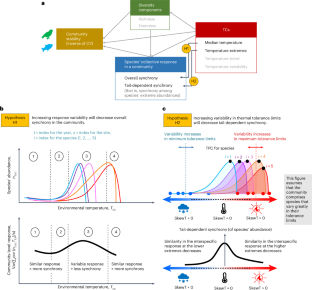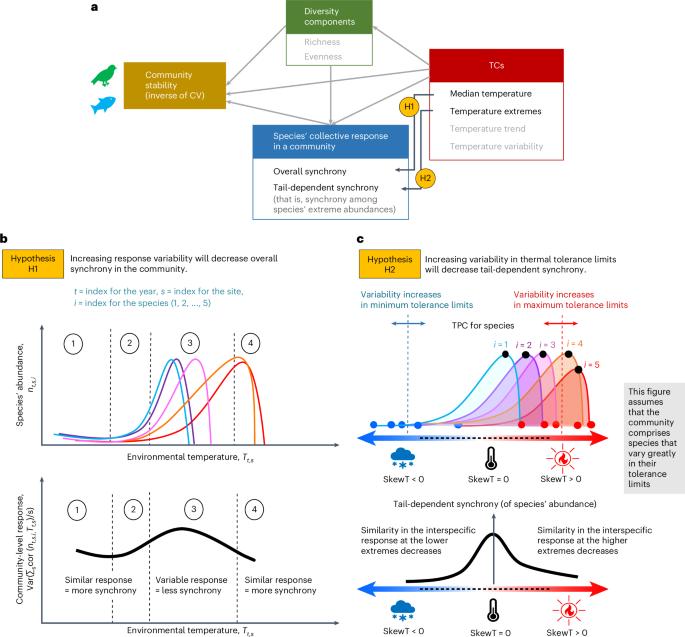温度和生物多样性对鸟类和鱼类群落稳定性的影响不同
IF 13.9
1区 生物学
Q1 ECOLOGY
引用次数: 0
摘要
确定影响群落稳定性的因素对于了解全球变暖情况下生物多样性和生态系统功能的维持至关重要。我们研究了温带地区 1,246 个鸟类群落和 580 个鱼类群落的四种温度成分(即中位数、变异性、趋势和极端温度)如何影响多样性-同步-稳定性关系。我们假设,如果物种对中位数温度变化的响应变化降低了群落的整体同步性(假设 H1),如果极端温度由于物种热耐受极限的变化降低了物种间在极端丰度下的同步性(假设 H2),那么群落就会产生稳定效应。我们在鱼类群落中发现了 H1 假设,在鸟类群落中发现了 H2 假设。在这里,我们发现非生物成分(即温度的中位数、变异性、趋势和极端温度)对群落稳定性的间接影响更大,主要是通过影响生物成分(即多样性、同步性)来实现的。考虑各种温度成分对陆生群落和水生群落稳定性的直接和间接影响,将有助于我们从机制上更好地理解生物多样性在全球气候压力下的变化。本文章由计算机程序翻译,如有差异,请以英文原文为准。


Temperature and biodiversity influence community stability differently in birds and fishes
Determining the factors that affect community stability is crucial to understanding the maintenance of biodiversity and ecosystem functioning in the face of global warming. We investigated how four temperature components (that is, median, variability, trend and extremes) affected diversity–synchrony–stability relationships for 1,246 bird and 580 fish communities from temperate regions. We hypothesized a stabilizing effect on the community if the variation in species’ response to changing median temperature decreases overall community synchrony (hypothesis H1) and if temperature extremes reduce interspecific synchrony at extreme abundances due to variation in species’ thermal tolerance limits (hypothesis H2). We found support for H1 in fish and for H2 in bird communities. Here we showed that the abiotic components (that is, the median, variability, trend and extremes of temperature) had more indirect effects on community stability, predominantly by affecting the biotic components (that is, diversity, synchrony). Considering various temperature components’ direct as well as indirect impacts on stability for terrestrial versus aquatic communities will improve our mechanistic understanding of biodiversity change in response to global climatic stressors. Four temperature components are shown to have different effects on diversity–synchrony–stability relationships in 1,246 bird communities versus 580 fish communities from temperate regions.
求助全文
通过发布文献求助,成功后即可免费获取论文全文。
去求助
来源期刊

Nature ecology & evolution
Agricultural and Biological Sciences-Ecology, Evolution, Behavior and Systematics
CiteScore
22.20
自引率
2.40%
发文量
282
期刊介绍:
Nature Ecology & Evolution is interested in the full spectrum of ecological and evolutionary biology, encompassing approaches at the molecular, organismal, population, community and ecosystem levels, as well as relevant parts of the social sciences. Nature Ecology & Evolution provides a place where all researchers and policymakers interested in all aspects of life's diversity can come together to learn about the most accomplished and significant advances in the field and to discuss topical issues. An online-only monthly journal, our broad scope ensures that the research published reaches the widest possible audience of scientists.
 求助内容:
求助内容: 应助结果提醒方式:
应助结果提醒方式:


